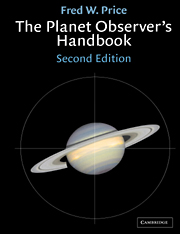Book contents
- Frontmatter
- Contents
- Foreword
- Preface
- Acknowledgements
- Abbreviations used in this book
- Introduction: Why observe the planets?
- 1 The Solar System
- 2 The celestial sphere
- 3 Telescopes and accessories
- 4 The atmosphere and seeing
- 5 Mercury
- 6 Venus
- 7 Mars
- 8 The minor planets (asteroids)
- 9 Jupiter
- 10 Saturn
- 11 Uranus
- 12 Neptune
- 13 Pluto
- 14 Constructing maps and planispheres
- 15 Planetary photography and videography
- 16 Photoelectric photometry of the minor planets, planets and their satellites
- Appendix: Milestones in Solar System exploration
- Name index
- Subject index
11 - Uranus
Published online by Cambridge University Press: 05 August 2012
- Frontmatter
- Contents
- Foreword
- Preface
- Acknowledgements
- Abbreviations used in this book
- Introduction: Why observe the planets?
- 1 The Solar System
- 2 The celestial sphere
- 3 Telescopes and accessories
- 4 The atmosphere and seeing
- 5 Mercury
- 6 Venus
- 7 Mars
- 8 The minor planets (asteroids)
- 9 Jupiter
- 10 Saturn
- 11 Uranus
- 12 Neptune
- 13 Pluto
- 14 Constructing maps and planispheres
- 15 Planetary photography and videography
- 16 Photoelectric photometry of the minor planets, planets and their satellites
- Appendix: Milestones in Solar System exploration
- Name index
- Subject index
Summary
General
Although visible to the naked eye as a sixth magnitude star, Uranus appears to have been unknown to the ancients. The planets previously described are all brighter than most naked eye stars and move rapidly among them and so attracted the attention of the peoples of old. Uranus, on the other hand, being faint and moving very slowly among the fixed stars did not attract attention. In the dark unpolluted skies of the ancient world it would be quite lost amongst the myriad stars that peppered the clear night skies of long ago. Uranus was, in fact, the first planet to be discovered, by William Herschel in 1781, who at first thought that it was a comet. He made the discovery with a home-made 6.2-inch reflector.
Uranus, like Jupiter and Saturn, is classed as a ‘gas giant7. It is an enormous rapidly rotating world with a low density and a thick atmosphere. Its equatorial diameter is 31763 miles (51 111 km) and the polar diameter is 30 811 miles (49 575 km). Uranus is therefore noticeably ellipsoidal, the ratio of the polar to equatorial diameter being 0.97. Compared to the Earth, Uranus is about four times larger (fig. 11.1).
Four of the Solar System planets have their rotational axes tilted from the perpendicular to their orbital planes by between 20° and 30°. The axis of Uranus is tilted 98° to the plane of the orbit and this makes it unique among the planets.
- Type
- Chapter
- Information
- The Planet Observer's Handbook , pp. 323 - 345Publisher: Cambridge University PressPrint publication year: 2000



